Imaging Company
As of November 29, 2012
Overview
Main Products
Digital cameras, film cameras, interchangeable lenses, speedlights, film scanners, accessories, software, sport optics
Consolidated Financial Results
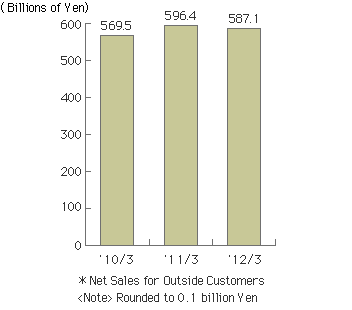
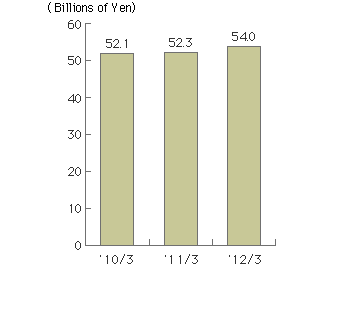
Market Environment and Business Trends
The digital camera—interchangeable lens type market continued to show expansion, although the compact digital camera market shrank. The Imaging Products Business is expected to show solid performance from an increase in sales volume of interchangeable lens type digital camera, particularly of highly acclaimed new products, even though challenging market conditions such as intensifying competition are expected.
Shipments of Digital Cameras
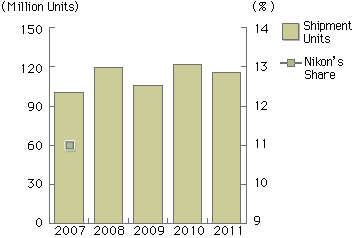
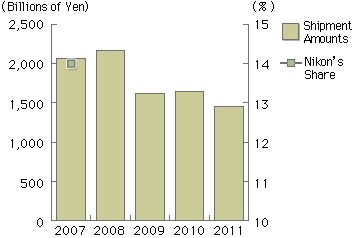
- Source: Camera & Imaging Products Association
- *Shipment units=domestic shipment units+export units (member manufacturers only)
Shipment amounts=domestic shipment amounts+export amounts (member manufacturers only) - *Nikon's share is not calculated from 2008 since officially announced figures by the Company are consolidated sales units.
Shipments of Digital Camera with Interchangeable Lens
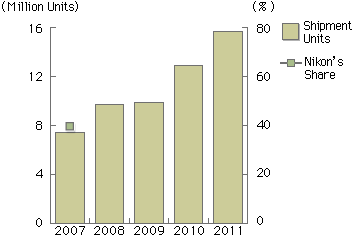
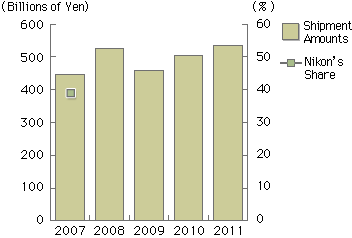
- Source: Camera & Imaging Products Association
- *Shipment units=domestic shipment units+export units (member manufacturers only)
Shipment amounts=domestic shipment amounts+export amounts (member manufacturers only) - *Nikon's share is not calculated from 2008 since officially announced figures by the Company are consolidated sales units.
See Financial and Business Data for the First Half ended September 30, 2012 (November 1, 2012)
Sales volume of Nikon Digital imaging products (Sales & Forecast)
- Digital Camera with Interchangeable Lens
- Interchangeable lenses
- Compact DSC
An Interview with the Company President
 Yasuyuki Okamoto
Yasuyuki Okamoto
Director, Member of the Board & Executive Officer, President of Imaging Company
- Q1:What were the business results and principal activities in the Imaging Company for the first half of the year ending March 2013?
In the Imaging Products market, the digital camera—interchangeable lens type market expanded, while the compact digital camera market shrank. In these circumstances, with regard to digital camera—interchangeable lens type, sales of digital single-lens reflex (SLR) cameras continued to grow, while the Nikon 1 brand, an advanced camera—interchangeable lens type, also continued to show solid performance.
In the compact digital camera market, sales volume of the 42x super-telephoto zoom model COOLPIX P510 and the slim, 18x optical zoom model COOLPIX S9300 showed favorable performance, resulting in a year-on-year increase in sales despite of market contraction. Sales volume of interchangeable camera lenses, high-priced camera lenses in particular, climbed steadily thanks to an expansion in sales of digital camera―interchangeable lens type.
As a result, net sales for the Imaging Products Business increased by 17.4% year on year to 381,071 million yen, marking a record high for half-year sales, as sales volume of digital camera―interchangeable lens type, compact digital cameras, and interchangeable camera lenses hit record highs for the first half of the year. However, operating income decreased by 11.8% year on year to 41,807 million yen, due to the impact of exchange rates, etc.
- Q2:What is the outlook for the digital camera market and Nikon's sales strategies?
-
A2:
The market for interchangeable lens-type digital cameras is expected to achieve double-digit annual growth in unit sales through the fiscal year ending March 2015. Although the flooding in Thailand impacted Nikon during the fiscal year ended March 2012, manufacturing capacity has been fully restored, and Nikon's global share for the recent 2Q regained around 40%. In the future, we intend to reinforce our market position. Meanwhile, the size of the compact digital camera market for the year ending March 2013 is expected to shrink to 80 million units with the downturn in the economy of emerging countries and the impact of smartphones. Following our success in the U.S. market, Nikon's highly focused marketing efforts enabled us to claim the top share in the European market for the fiscal year ended March 2012. Competition is becoming increasingly fierce, but we intend to maintain our leading market position through the effective combination of desirable products, compelling advertising, and strong marketing capability.
To increase the Imaging Company's market share, our current Medium Term Management Plan calls for the "steady introduction of new products with distinctively superior technologies." The Nikon 1 interchangeable lens-type advanced digital camera represents one fruit of this ongoing strategy. The Nikon 1 is favored by women and young people, segments of the market where Nikon has traditionally been weak. However, it is also accepted as an attractive second camera for digital SLR owners. As a result, the Nikon 1 is succeeding in carving out an entirely new market, distinct from the conventional digital SLR and compact digital camera markets. The reason for its success among consumers lies in the fact that the technologies used in this camera were developed as the result of a thorough analysis of actual user needs. For example, users of compact digital cameras tend to report dissatisfaction with the autofocus speed. The Nikon 1 addressed this issue by introducing the world's first*2 image sensor, created for an interchangeable lens-type digital camera, that comes with a focal plane phase-detection autofocus, providing high-speed, highly accurate autofocus capability. The fact that this camera also allows the user to simultaneously capture video and high-resolution still images, offers the user a new way to enjoy photography.
As is the case with the D800 digital SLR model, which features an advanced image sensor and a superior image-processing engine, we believe that despite the relatively higher prices, products with a clear technological edge will continue to succeed in the marketplace. We will maintain our focus on the development of innovative technologies and products that incorporate those technologies, centering on camera bodies and NIKKOR interchangeable lenses, to meet the ever-evolving needs of our customers.
- *2As of September 21, 2011
- Q3:What are your initiatives for expanding market share in emerging markets?
-
A3:
When we look to the future of the imaging business, our keyword has got to be emerging markets. Much of Nikon's future success will depend on how much market share we are able to capture in developing countries that still have a strong potential for future economic expansion. We already have a solid market share in some of these emerging countries, but many other areas await development. Brand strength is extremely important in these countries, where establishment of strong brand appeal will lead to brand-based demand.
The Nikon brand is already well established in India, Russia and China, where we consistently command a strong share of the market. However, Nikon remains relatively weak in much of Central and South America, the Middle East, Africa and parts of Southeast Asia. We will focus on improving our brand image in these regions. As part of these efforts, in addition to the sales subsidiaries we have already established in Thailand, Brazil and the United Arab Emirates, we will now turn our attention to reinforcing our sales and service systems in Central and South America and the Middle East.
- Q4:What are the priority issues for the Imaging Company in areas other than products and the sales structure?
-
A4:
One of the areas on which I am personally focusing special attention is our brand image. While maintaining the legendary Nikon name for unsurpassed technology and quality, I want to add some new elements to our brand image, such as "fashionable" and "sophisticated." The two products that best embody these new concepts are the Nikon 1, and the COOLPIX series compact digital camera. As they steadily penetrate the market, these two products are beginning to create a very positive new Nikon image that combines the elements of our traditional brand with the new elements of being fashionable and sophisticated.
A second area on which I am placing special emphasis is ensuring that our imaging business is market driven. This requires not only a strong marketing capability, but also demands that we build our ability to create new and advanced technologies to meet user needs, and ensure that our manufacturing capability is the best in the industry. With regard to manufacturing, we are currently working to simplify design work through the adoption of platform-based design systems, and we are looking to cut costs through the increased use of automation. As the person in charge of Nikon's imaging business, I am pleased to report that these new approaches are already beginning to show solid results.
- Precision Equipment Company
- Imaging Company
- Instruments Company

